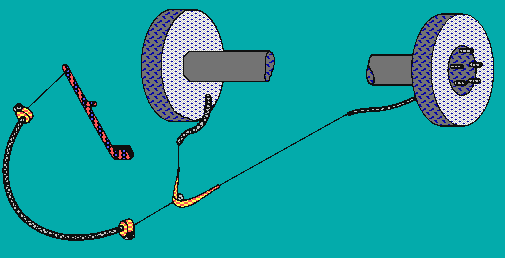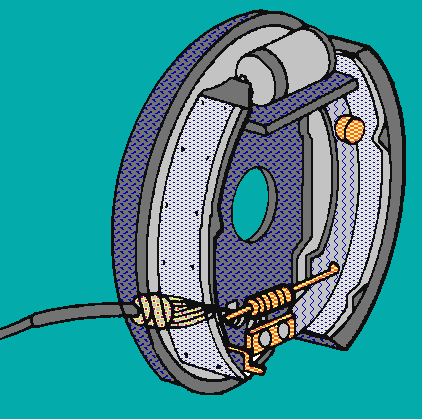PARKING BRAKES and FUEL ECONOMY?
- GOAL:
- To understand how an improperly adjusted parking brake is dangerous and also causes poor fuel economy.
- OBJECTIVE:
- The student will:
- 1. Identify the different types of parking brake systems.
- 2. Demonstrate how to properly adjust the parking brake.
- LESSON/INFORMATION:
- Parking brakes are important to the safety of the driver. All manufacturers and driver educators recommend setting the parking brake when parking a vehicle. This action prevents the vehicle from rolling while not placing undue stress on the internal system of the transmission.
- Correct parking brake adjustment results in optimum operation. Improper adjustment could result in the parking brake not holding or in dragging brakes. For many vehicles, a properly adjusted parking brake is necessary so that the service brakes function properly.
- The conditions and some possible consequences for improperly adjusted parking brakes are:
- 1. Too loose:
- a. Parked vehicle may roll;
- b. Increased brake response time;
- c. Altered front-to-rear braking ratio.
- 2. Too tight:
- a. Reduced fuel economy - a result of brakes dragging;
- b. Premature worn shoes/pads - a result of brakes dragging;
- c. Reduced braking power - a result of overheating and brake fade;
- d. Over sensitive brakes - a result of too little brake pedal travel prior to shoe/pad to drum/rotor engagement.
- Types of Parking Brakes:
- All passenger cars and light trucks use some form of rear wheel parking brake. Large trucks and off-road vehicles use other systems. The majority of cars and light trucks use drum brakes on the rear. Some do use rear disc brakes. Since parking brake mechanisms for rear disc brakes vary greatly they will not be discussed in this guide. Rear drum brakes are either self adjusting (the vast majority), semi-self adjusting, or non-self adjusting. The purpose of any drum brake adjustment is to keep the shoe as close to the drum as possible, yet still not have the shoe contact the drum while the brake is released.
- Many technicians think the parking brake adjustment is not needed for self adjusting brakes. This is erroneous. Properly operating, the self adjusting brake compensates for shoe wear and restores proper shoe-to-drum clearance. The parking brake is a mechanical cable device that operates a (the) shoe(s) (see Figure 1a and 1b). If the cable has too much slack the shoes will not fully engage the drum before the parking brake reaches full travel. A cable that is too tight results in a (the) shoe(s) dragging the brake drum when the brakes are supposed to be released.

Figure 1a

Figure 1b
- Semi-self adjusters are self adjusters in which some operator action results in the brake shoes being adjusted. This system has recently become more popular. Activation of the parking brake is a commonly used method of activating these semi-self adjustments. For this system to operate correctly, the parking brake must be properly adjusted. Improper parking brake adjustment could result in brake drag or improper brake responses.
- Non-self adjusting brakes require periodic technician adjustment. As part of these regular adjustments, proper parking brake adjustment is recommended to avoid shoe drag or excessive parking brake travel.
- Parking brake adjustment status may be quickly assessed by applying the parking brake. With the vehicle stopped, fully apply the parking brake. Full engagement should take place near or less than ½ the parking brake's travel. If the parking brake travels more than half the distance, it could be too loose. If the parking brake fully engages in less than ¼ travel it could be too tight. Remember, too loose and the vehicle rolls; too tight, brakes drag and mpg is reduced.
- If the parking brake is fully engaged, with engine running place the transmission in a forward gear and try to move the vehicle. The brake should hold. It is normal for some parking brakes not to effectively hold when this test is run in reverse gear.
- ACTIVITY:
- 1. Select a car or light truck. Note information on data sheet.
- 2. Describe this vehicle's brake system. Respond to each of these questions.
- a. Are disc brakes, drum brakes or some combination used?
- b. Is there a power assist system? Are anti-lock brakes used? If so, how many channels?
- c. What type of parking brake system is used?
- 3. In the shop manual, locate the proper parking brake section for this vehicle.
- a. Summarize the adjustment procedures for adjusting this vehicle's parking brake.
- b. In the block provided, sketch the parking brake cable system; highlight each adjustment point.
- 4. Perform the parking brake quick test as outlined in the Lesson/Information section of this guide. Did the parking brake seem to respond correctly?
- 5. Summarize the findings. Report on any adjustments and repairs. Have your instructor check the vehicle for proper operation.
DATA SHEET
Name:________________________________ Date Activity Completed:__________________
- 1.
- Make______________________________________________________________________
- Model_____________________________________________________________________
- Year______________________________________________________________________
- 2. Describe the type of brake system (disc, drum, power, etc.):
- A.________________________________________________________________________
- B.________________________________________________________________________
- C.________________________________________________________________________
- 3. From an appropriate shop manual, complete the following:
- a. Summarize the adjustment procedure for adjusting the parking brakes:
- ___________________________________________________________________________
- ___________________________________________________________________________
- ___________________________________________________________________________
- In the space provided, sketch a diagram of the parking brake cable system; highlight each adjustment point.
- 4. Quick test results (check one):
- a. ____ Brake OK
- b.____ Brake too tight
- c.____ Brake slipped some
- d.____ Brake did not hold
- e.____ Brake held but more than ½ travel
- If a. was checked, sheet is complete. Summarize and report to instructor.
- If boxes b., c., d., or e., were checked, inspect the parking brake system and perform the necessary adjustments and/or repairs. Summarize the adjustments and/or repairs and report to the instructor.
- 5. Summarize:
- ___________________________________________________________________________
- ___________________________________________________________________________
- ___________________________________________________________________________
- ___________________________________________________________________________
- INFORMATION CHECK
- Directions: Indicate whether the statements below are true or false. If the statement is false, explain why it is false.
- 1._______ Self adjusting parking brakes never need adjustments.
- 2._______ To activate semi-self adjusting brakes, some operator's input is required.
- 3._______ A parking brake that travels only ¼ to full engagement may be too tight resulting in reduced mpg.
- 4._______ If the vehicle has self adjusting brakes, the parking brake needs no additional adjustment.
- 5._______ Most cars and light trucks use a combination of disc and drum brakes.
- TEACHER'S NOTES
- Many technicians overlook parking brakes during routine inspection and repairs. The omitted parking brake adjustment could cost the owner/operator fuel or brake shoes or damaged vehicle. It could also cost the technician in repeat repairs and with dissatisfied customers.
- ANSWERS TO INFORMATION CHECK
- 1. False - Every parking brake system has at least some initial adjustment.
- 2. True
- 3. True
- 4. False - Check the manuals! Some vehicles still require periodic parking brake adjustments to maintain proper parking brake travel. When the shoes are replaced, the travel adjustment must be reset to prevent shoe drag and loss of mpg.
- 5. True
- RECOMMENDED READING:
- Automotive Braking Systems. Pages 82-96; Pages 346-398.
- REFERENCES:
- Birch, Thomas W. Automotive Braking Systems. Harcourt Brace Jovanivich, Orlando, FL. 1988.
- Ellinger, Herbert E. Automechanics, 4th Edition. Prentice Hall, Englewood Cliffs, NJ. 1988.
Comments or questions to: TechAsmt@LA.GOV
Return to Automotive Menu



